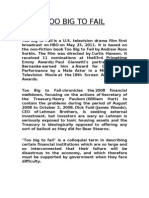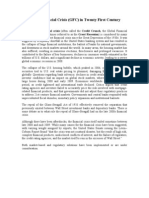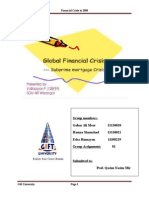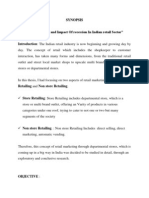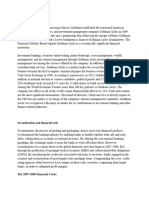Assingment Tahir
Assingment Tahir
Uploaded by
abbasdabkalanCopyright:
Available Formats
Assingment Tahir
Assingment Tahir
Uploaded by
abbasdabkalanCopyright
Available Formats
Share this document
Did you find this document useful?
Is this content inappropriate?
Copyright:
Available Formats
Assingment Tahir
Assingment Tahir
Uploaded by
abbasdabkalanCopyright:
Available Formats
http://en.wikipedia.org/wiki/Financial_crisis SUMMARY OF FINANCIAL CRISES 2007.
The economical problems of 20072008, also known as the international economical trouble and 2008 economical problems, is considered by many economic experts to be the worst economical problems since the Great Depression of the Thirties.It led to the risk of total failure of large banking institutions, the bailout of banks by national government authorities, and downturns in stock markets around the world. In many areas, the housing industry also suffered, resulting in evictions, home property foreclosures and extended lack of employment. The problems played a significant role in the failure of key businesses, decreases in consumer wealth estimated in billions of US dollars, and a recession in business activities leading to the 2008 2012 international recession and causing the European sovereign-debt problems. The active phase of the problems, which demonstrated as a assets problems, can be old from Aug 7, 2007 when BNP Paribas ended distributions from three protect funds stating "a complete water loss of liquidity". The exploding of the U.S. property percolate, which actually peaked in 2006, caused the of investments tied to U.S. property costs to drop, damaging banking organizations globally.The economic problems was activated by a complex interaction of government policies that motivated owning a home, providing easier access to loans for subprime people, overvaluation of included sub-prime loans based on the concept that property prices would continue to increase, doubtful trading methods on part of both consumers, compensation components that focus on short-term deal flow over long-term value creation, and a lack of adequate capital holdings from financial organizations and insurance providers to back the economical responsibilities they were making.Questions regarding bank solvency, decreases in credit score accessibility and broken trader confidence had an impact on global stock markets, where investments experienced large failures during 2008 and early 2009. Financial systems globally bogged down during this period, as credit score stiffened and international trade dropped.Governments and central financial organizations reacted with unmatched financial stimulation, financial policy development and institutional relief. In the U.S., The legislature passed the American Recovery and Reinvestment Act of 2009. In the EU, the UK reacted with austerity measures of spending cuts and tax improves without trade growth and it has since slid into a double-dip recession. Many causes for the economic problems have been suggested, with different weight allocated by experts.The U.S. Senate's LevinCoburn Report stated that the problems was the result of "high danger, complex economical products; undisclosed disputes of interest; the failing of authorities, the money score score organizations, and the market itself to control in the extravagances of Wall Street. The 1999 repeal of the GlassSteagall Act effectively removed the separating between investment financial institutions and depository financial institutions in the
United States. Experts suggested that credit rating score organizations and traders failed to perfectly price the danger involved with mortgage-related economical loans, and that government authorities did not modify their regulating methods to address 21st-century markets. Research into the causes of the economic problems has also focused on the role of attention rate propagates. In the immediate consequences of the economic problems modern financial and financial policies were implemented to reduce the shock to the economy. In September, 2010, the DoddFrank regulating changes were introduced to reduce the chance of a repeat.
BACKGROUND The immediate cause or trigger of the problems was the exploding of the United States actual property percolate which actually peaked in approximately 20052006. Already-rising default rates on "subprime" and adjustable-rate mortgages (ARM) started to increase quickly thereafter. As banks started to give out more financial loans to potential property owners, actual property costs started to rise. Easy option credit score in the US, motivated by large inflows of foreign funds after the European financial debt problems and Oriental economic problems of the 1997-1998 period, led to a actual property construction growth and triggered debt-financed consumer spending. Lax lending requirements and increasing property costs also contributed to the Real estate percolate. Loans of various types (e.g., mortgage, bank card, and auto) were simple to obtain and consumers presumed an unmatched financial debt load. As part of the real estate and credit booms, the number of economical contracts called mortgagebacked investments (MBS) and collateralized debt responsibilities (CDO), which derived their value from home and real estate costs, greatly improved. Such economical advancement allowed organizations and traders around the world to invest in the U.S. real estate industry. As real estate costs dropped, major global mortgage companies that had obtained and spent intensely in subprime MBS revealed significant failures. Falling costs also led to homes worth less than the home mortgage, providing a economical motivation to enter property foreclosure. The continuous property foreclosure plague that began in late 2006 in the U.S. continues to strain wealth from consumers and erodes the economical strength of mortgage companies. Fails and failures on other mortgage types also more than doubled as the problems extended from the real estate industry to other parts of the economy. Total failures are approximated in the billions of U.S. dollars worldwide.
Share in GDP of U.S. economical sector since 1860
While the housing and credit score pockets were building, a series of factors caused the financial climate to both expand and become progressively fragile, a process called financialization. U.S. Government policy from the 70's forward has highlighted deregulation to motivate company, which resulted in less management of actions and less disclosure of information about new actions performed by financial institutions and other changing loan companies. Thus, policymakers did not immediately recognize the progressively part played by loan companies such as investment financial institutions and protect resources, also known as the shadow banking program. Some experts believe these organizations had become as essential as professional (depository) financial institutions in offering credit score to the U.S. economy, but they were not subject to the same regulations. These organizations, as well as certain regulated financial institutions, had also presumed essential debt problems while offering the loans described above and did not have a economical support sufficient to absorb large loan fails or MBS failures. These failures impacted the ability of loan companies to offer, reducing company actions. Concerns regarding the stability of key loan companies forced central financial institutions to provide resources to motivate lending and restore faith in the professional paper markets, which are integral to funding company functions. Government authorities also skipped out key loan companies and applied financial stimulus programs, assuming essential additional economical responsibilities.
You might also like
- Too Big To FailDocument9 pagesToo Big To FailPriyank Hariyani0% (1)
- Global Financial CrisisDocument7 pagesGlobal Financial CrisiskendecruzNo ratings yet
- Crisis and 2008 Financial Crisis, Is Considered by Many Economists To Be The WorstDocument54 pagesCrisis and 2008 Financial Crisis, Is Considered by Many Economists To Be The Worstdineshpatil186No ratings yet
- Global Financial CrisisDocument3 pagesGlobal Financial Crisisarahman1984No ratings yet
- Economic Recession 2008Document6 pagesEconomic Recession 2008Osama AhmedNo ratings yet
- Assignment 2Document7 pagesAssignment 2Wasim Bin ArshadNo ratings yet
- Global Financial Crisis of 2008Document8 pagesGlobal Financial Crisis of 2008adilahtabassumNo ratings yet
- Late-2000s Financial Crisis SubprimeDocument32 pagesLate-2000s Financial Crisis SubprimeJayati BhasinNo ratings yet
- Financial Crisis of 2008 Momodou JallowDocument17 pagesFinancial Crisis of 2008 Momodou JallowJester BorresNo ratings yet
- Financial Crisis of 2007-2010 in US: Evolution of Economic SystemsDocument24 pagesFinancial Crisis of 2007-2010 in US: Evolution of Economic Systemsanca_giorgiana01No ratings yet
- Finance Assignment Financial CrisisDocument3 pagesFinance Assignment Financial CrisisTayyaba TariqNo ratings yet
- Global Financial Crisis (Edited)Document7 pagesGlobal Financial Crisis (Edited)AngelicaP.Ordonia100% (1)
- Financial Crisis of 2007Document27 pagesFinancial Crisis of 2007Houssem Eddine BoumallougaNo ratings yet
- MBF Group AsgnmentDocument10 pagesMBF Group AsgnmentEshahumayounNo ratings yet
- Financial Markets Final SubmissionDocument10 pagesFinancial Markets Final Submissionabhishek kumarNo ratings yet
- Derivatives (Fin402) : Assignment: EssayDocument5 pagesDerivatives (Fin402) : Assignment: EssayNga Thị NguyễnNo ratings yet
- Daily News Editorials - Understanding Financial Crisis of 2007 08 - Print - ManuallyDocument3 pagesDaily News Editorials - Understanding Financial Crisis of 2007 08 - Print - Manuallysarveshsing2690No ratings yet
- DoneDocument275 pagesDoneNeha TalwarNo ratings yet
- Global Economic Crisis 2008Document9 pagesGlobal Economic Crisis 2008madhav KaushalNo ratings yet
- Global Economic Crisis 2008Document9 pagesGlobal Economic Crisis 2008madhav KaushalNo ratings yet
- Question #1 What Caused Global Financial Crises? .Write Brief Overview?Document3 pagesQuestion #1 What Caused Global Financial Crises? .Write Brief Overview?Dua ArshadNo ratings yet
- 2008 Financial CrisisDocument9 pages2008 Financial CrisisalexNo ratings yet
- Mortage Crises. (Adeel Ahmad)Document6 pagesMortage Crises. (Adeel Ahmad)Adeel AhmadNo ratings yet
- Financial Crisis of 2007-2010Document30 pagesFinancial Crisis of 2007-2010Haris AzizNo ratings yet
- 1st AssDocument4 pages1st AssUsman GhaniNo ratings yet
- Historical View On The Crisis of 2007Document4 pagesHistorical View On The Crisis of 2007jansher_wazirNo ratings yet
- 2008 GlobalFinancialCrisisDocument13 pages2008 GlobalFinancialCrisisAdithya SNo ratings yet
- 1st AssDocument3 pages1st AssUsman GhaniNo ratings yet
- Causes and Effects of The Sub Prime Mortgage CrisisDocument5 pagesCauses and Effects of The Sub Prime Mortgage CrisisRayan RehmanNo ratings yet
- The Global Financial Crisis - Causes and Solutions.Document5 pagesThe Global Financial Crisis - Causes and Solutions.Sherlene GarciaNo ratings yet
- The Role of Accounting Standards That Causing or Exacerbating The GlobalDocument10 pagesThe Role of Accounting Standards That Causing or Exacerbating The GlobalHưng LâmNo ratings yet
- U.S. Subprime Mortgage Crisis (A & B)Document8 pagesU.S. Subprime Mortgage Crisis (A & B)prabhat kumarNo ratings yet
- 2008 Credit CrisisDocument7 pages2008 Credit Crisis982063957No ratings yet
- Impact of Credit Crisis On International / Global BusinessesDocument6 pagesImpact of Credit Crisis On International / Global BusinessesMabu MabuNo ratings yet
- Causes and Consequences of The 2008 Financial CrisDocument6 pagesCauses and Consequences of The 2008 Financial Crismsuyaabubakari1No ratings yet
- Project Finance - Assignement (Final Draft)Document26 pagesProject Finance - Assignement (Final Draft)SamyakJainNo ratings yet
- What Caused The Great RecessionDocument12 pagesWhat Caused The Great RecessionchenNo ratings yet
- Understanding Financial Crisis of 2007 08Document3 pagesUnderstanding Financial Crisis of 2007 08Mahesh MohurleNo ratings yet
- Subprime CrisisDocument5 pagesSubprime CrisisMayank Jain100% (5)
- 2008 Economic CrisisDocument5 pages2008 Economic Crisiskhushbuali344No ratings yet
- K204040222 - Phạm Trần Cẩm Vi 4Document4 pagesK204040222 - Phạm Trần Cẩm Vi 4Nam Đỗ PhươngNo ratings yet
- Groupwork Assignment Submission 3 M7Document9 pagesGroupwork Assignment Submission 3 M7Abdullah AbdullahNo ratings yet
- Global Financial CrisisDocument9 pagesGlobal Financial CrisisAnkit Sanjay KhetanNo ratings yet
- Background and Timeline of Events: 2007-2010 Financial CrisisDocument35 pagesBackground and Timeline of Events: 2007-2010 Financial CrisisManisha GoelNo ratings yet
- Fin 433Document3 pagesFin 433sabirwaqif.khanNo ratings yet
- Subprime Mortgage CrisisDocument35 pagesSubprime Mortgage CrisisVineet GuptaNo ratings yet
- Credit Where DueDocument9 pagesCredit Where Duedecker4449No ratings yet
- Aftermath Bubble - Great RecessionDocument2 pagesAftermath Bubble - Great RecessionGwenn PosoNo ratings yet
- Economics ProjectDocument34 pagesEconomics ProjectRuhan MasaniNo ratings yet
- Shamik Bhose The Coming Economic ChangesDocument5 pagesShamik Bhose The Coming Economic ChangesshamikbhoseNo ratings yet
- Causes and Consequences of The 2023 Banking CrisisDocument11 pagesCauses and Consequences of The 2023 Banking CrisisBoy In The BoxNo ratings yet
- Macroeconomics Assignment 4Document7 pagesMacroeconomics Assignment 4AMOGHSHANKER GOSWAMINo ratings yet
- Ho Chi Minh City International University Critical ThinkingDocument25 pagesHo Chi Minh City International University Critical ThinkingChi NguyenNo ratings yet
- Global Financial Crisis 2008Document7 pagesGlobal Financial Crisis 2008Debakanta MohantyNo ratings yet
- 2008 Financial Crisis Causes and CostsDocument6 pages2008 Financial Crisis Causes and Costszarnigoroqmamatova66No ratings yet
- 2008 Financial Crisis Subprime Mortgage Crisis Caused by The Unregulated Use of Derivatives U.S. Treasury Federal Reserve Economic CollapseDocument4 pages2008 Financial Crisis Subprime Mortgage Crisis Caused by The Unregulated Use of Derivatives U.S. Treasury Federal Reserve Economic CollapseShane TabunggaoNo ratings yet
- Financial System and The Subprime CrisisDocument21 pagesFinancial System and The Subprime CrisisEdd DeNo ratings yet
- Causes of The Financial Crisis 2010 PDFDocument10 pagesCauses of The Financial Crisis 2010 PDFSilvana ElenaNo ratings yet
